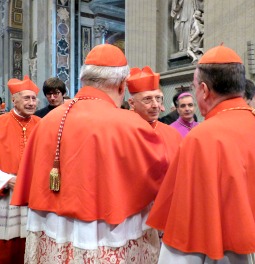In Rome, February Will Be a Time for Cardinals
The Vatican has confirmed a consistory for the creation of new cardinals will take place on Feb. 22, and other key gatherings also are scheduled.

VATICAN CITY — The Vatican has confirmed that a consistory for the creation of new cardinals will be held on Feb. 22, the feast of the Basilica of St. Peter.
Noting that such an early announcement is unusual, the director of the Holy See Press Office, Jesuit Father Federico Lombardi, said Pope Francis had decided to convoke the consistory “in advance in order to facilitate the planning of other meetings involving the participation of cardinals from different parts of the world.”
The Vatican spokesman also recalled that the Holy Father had voiced his intention to hold the consistory on that date at two recent meetings: the Oct. 1-3 gathering of the eight-member council of cardinals, convened to discuss Church governance and reforming the Roman Curia, and at a subsequent meeting of the Synod Council on Oct. 7-8.
“It is foreseen that the Pope, like his predecessors on other occasions, intends for the consistory to be preceded by a meeting of the college of cardinals,” Father Lombardi said, adding that, before the consistory, the council of cardinals will hold their third meeting on Feb. 17-18.
As of Oct. 21, there were 109 cardinals under the age of 80, and so eligible to vote in a conclave. That is 11 short of the maximum number of 120 advised by Paul VI. By February, that shortfall will rise to at least 14.
This will be the first opportunity for the Pope to choose new cardinals, although the College of Cardinals will remain reflective of the pontificate of Benedict XVI for some time, as more than half of the current college is composed of the pope emeritus’ appointments.
Who exactly will be chosen is, of course, open to speculation. Some Vatican observers say it’s likely that he will choose more cardinals from outside Europe and from the developing world. This includes candidates not only in Latin America, but also Africa, and especially Asia, where he hopes to visit next year.
New American Cardinals?
Possible contenders for a “red hat” in the U.S. include Archbishops Charles Chaput of Philadelphia, William Lori of Baltimore and José Gomez of Los Angeles — each traditionally cardinalatial sees. But the Pope is under no obligation to follow tradition, and during his brief pontificate, he has demonstrated a willingness to break with it, so it’s possible none of these U.S. archbishops will be named cardinals.
Similarly with Italy, which has proportionally a very high number of cardinals, the Pope could choose to break with custom. The sees of Turin, an archdiocese, and Venice, a patriarchate, for example, have traditionally been headed by cardinals, but currently that is not the case. Francis could conceivably pass over both, though this is thought to be unlikely.
The Church in England, Scotland and Wales, meanwhile, has been without a non-retired cardinal, eligible to vote in a conclave, for some time. A leading candidate for a red hat there is Archbishop Vincent Nichols of Westminster. Scotland, too, could possibly have a new cardinal by the end of February.
Vatican Candidates
Within the Vatican, his choices are more predictable. Very probable candidates are the new Vatican secretary of state, Archbishop Pietro Parolin, the prefect of the Congregation for the Doctrine of the Faith, Archbishop Gerhard Müller, and the new prefect of the Congregation for the Clergy, Archbishop Beniamino Stella.
Some have speculated that Cardinal Joao Braz de Aviz, prefect of the Congregation for Institutes of Consecrated Life and Societies of Apostolic Life, may also be stepping down soon, an opening that would create another candidate for the red biretta.
Soon, a number of other cardinals will vacate positions usually held by cardinals, as they have already surpassed 75, the normal retirement age of bishops. In the Vatican, these include the president of the Pontifical Council for Legislative Texts, Cardinal Francesco Coccopalmerio, and the president of the Pontifical Council for Pastoral Care of Migrants and Itinerant People, Cardinal Antonio Maria Veglio.
Cardinals elsewhere who have passed retirement age include Cardinal Francis George of Chicago; Cardinal Carlo Caffarra of Bologna, Italy; Cardinal Paolo Romero of Palermo, Italy; Cardinal Joachim Meisner of Cologne (he turns 80 on Christmas Day); Cardinal Lluis Martinez Sistach of Barcelona; Cardinal Raymundo Damasceno Assis of Aparecida, Brazil; and Cardinal Antonio Maria Rouco Varela of Madrid.
According to sources, Cardinal Ruoco, who is 77, will probably be replaced soon by Cardinal Antonio Canizares Llovera, currently prefect of the Congregation for Divine Worship and the Discipline of the Sacraments. But if so, Cardinal Canizares’ successor as head of the liturgical congregation would also be in line for a red hat.
However, when these retirement-age cardinals will step down from their offices — and who will replace them — might not be known before the consistory. And in these cases, too, Pope Francis could choose to give red hats to those heading entirely different dioceses or positions.
Other Meetings
After the consistory, the Vatican said the Synod Council will meet again on Feb. 24-25 to discuss the upcoming Synod on the Family and Evangelization, due to take place in October 2014.
The Vatican also said that the next meeting of the council of cardinals for economic and organizational matters of the Holy See (the so-called “Council of Fifteen”) is also expected to be scheduled, as in previous years, for the month of February, probably during the week before the consistory.
Edward Pentin is the Register’s Rome correspondent.












